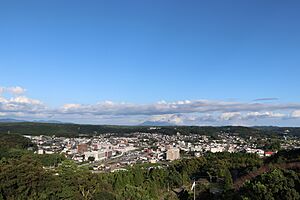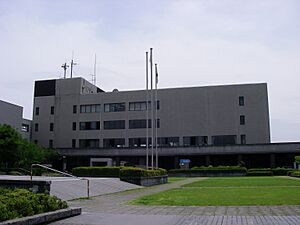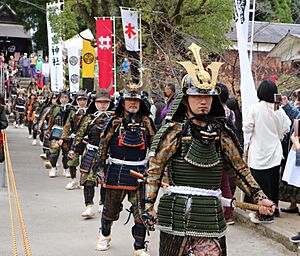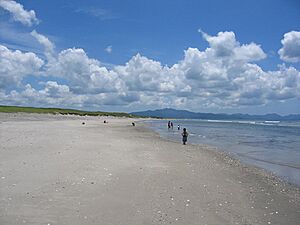Hioki, Kagoshima facts for kids
Quick facts for kids
Hioki
日置市
|
|||||||||||
|---|---|---|---|---|---|---|---|---|---|---|---|

Ijūin city from the Joyama Park in 2020
|
|||||||||||
|
|||||||||||
 |
|||||||||||
| Country | Japan | ||||||||||
| Region | Kyushu | ||||||||||
| Prefecture | Kagoshima | ||||||||||
| Area | |||||||||||
| • Total | 253.01 km2 (97.69 sq mi) | ||||||||||
| Population
(July 1, 2024)
|
|||||||||||
| • Total | 46,348 | ||||||||||
| • Density | 183.186/km2 (474.451/sq mi) | ||||||||||
| Time zone | UTC+09:00 (JST) | ||||||||||
| City hall address | 1-100 Kori Ijuin-machi, Hioki-shi, Kagoshima-ken 899-2592 | ||||||||||
| Climate | Cfa | ||||||||||
|
|||||||||||
Hioki (日置市, Hioki-shi) is a city located in Kagoshima Prefecture, Japan. As of July 1, 2024, Hioki had about 46,348 people living in 22,706 homes. The city covers a total area of 253.01 square kilometers (97.69 sq mi).
Contents
Exploring Hioki's Location
Hioki is in the middle of Kagoshima Prefecture. It is on the western side of the Satsuma Peninsula. The city's western part faces the East China Sea.
Hioki's Famous Beach
One of Japan's three largest sand dunes, Fukiagehama Beach, is located here. There is also a small, uninhabited island called Kutajima. It is about 12 kilometers (7.5 mi) offshore from Fukiagehama Beach.
Neighboring Towns and Cities
Hioki shares borders with several other places in Kagoshima Prefecture:
- Ichikikushikino
- Kagoshima
- Minamisatsuma
- Satsumasendai
Hioki's Weather and Climate
Hioki has a humid subtropical climate. This means it has hot summers and mild winters. It rains a lot throughout the year, especially in June and July.
Temperature and Rainfall
The average yearly temperature in Hioki is about 17.3°C (63.1°F). The city gets about 2265.0 mm (89.17 in) of rain each year. June is usually the wettest month.
The warmest month is August, with an average temperature of about 27.3°C (81.1°F). January is the coldest month, with an average of 7.5°C (45.5°F). The highest temperature ever recorded was 36.3°C (97.3°F) on August 19, 2013. The lowest was -6.3°C (20.7°F) on February 19, 1977.
| Climate data for Higashiichiki, Hioki (1991−2020 normals, extremes 1977−present) | |||||||||||||
|---|---|---|---|---|---|---|---|---|---|---|---|---|---|
| Month | Jan | Feb | Mar | Apr | May | Jun | Jul | Aug | Sep | Oct | Nov | Dec | Year |
| Record high °C (°F) | 22.4 (72.3) |
23.2 (73.8) |
24.7 (76.5) |
29.4 (84.9) |
30.6 (87.1) |
33.2 (91.8) |
36.3 (97.3) |
36.3 (97.3) |
35.5 (95.9) |
32.9 (91.2) |
27.8 (82.0) |
23.6 (74.5) |
36.3 (97.3) |
| Mean daily maximum °C (°F) | 12.0 (53.6) |
13.3 (55.9) |
16.1 (61.0) |
20.4 (68.7) |
24.1 (75.4) |
26.4 (79.5) |
30.2 (86.4) |
31.6 (88.9) |
29.3 (84.7) |
25.1 (77.2) |
19.8 (67.6) |
14.4 (57.9) |
21.9 (71.4) |
| Daily mean °C (°F) | 7.5 (45.5) |
8.6 (47.5) |
11.5 (52.7) |
15.6 (60.1) |
19.4 (66.9) |
22.8 (73.0) |
26.6 (79.9) |
27.3 (81.1) |
24.6 (76.3) |
19.8 (67.6) |
14.6 (58.3) |
9.5 (49.1) |
17.3 (63.2) |
| Mean daily minimum °C (°F) | 2.9 (37.2) |
3.6 (38.5) |
6.4 (43.5) |
10.5 (50.9) |
14.8 (58.6) |
19.6 (67.3) |
23.6 (74.5) |
23.9 (75.0) |
20.7 (69.3) |
15.0 (59.0) |
9.5 (49.1) |
4.7 (40.5) |
12.9 (55.3) |
| Record low °C (°F) | −5.4 (22.3) |
−6.3 (20.7) |
−3.4 (25.9) |
−0.1 (31.8) |
5.4 (41.7) |
11.0 (51.8) |
17.0 (62.6) |
16.4 (61.5) |
10.0 (50.0) |
1.6 (34.9) |
−2.1 (28.2) |
−4.2 (24.4) |
−6.3 (20.7) |
| Average precipitation mm (inches) | 75.8 (2.98) |
99.4 (3.91) |
151.1 (5.95) |
174.3 (6.86) |
187.1 (7.37) |
516.3 (20.33) |
310.2 (12.21) |
240.6 (9.47) |
243.6 (9.59) |
92.2 (3.63) |
111.4 (4.39) |
98.4 (3.87) |
2,265 (89.17) |
| Average precipitation days (≥ 1.0 mm) | 10.2 | 9.6 | 12.3 | 10.2 | 10.0 | 15.1 | 10.9 | 10.3 | 10.2 | 7.2 | 9.0 | 9.5 | 124.5 |
| Mean monthly sunshine hours | 116.1 | 133.3 | 162.3 | 180.6 | 183.9 | 112.0 | 192.5 | 220.8 | 186.7 | 191.2 | 156.1 | 126.2 | 1,964.9 |
| Source: Japan Meteorological Agency | |||||||||||||
Hioki's Population Over Time
The population of Hioki in 2020 was 47,153 people. The city started its first population count in 1960. After a small decrease in the 1970s, the number of people living in Hioki stayed pretty steady until 2020.
| Historical population | ||||||||||||||||||||||||||||||||||||||||||||||
|---|---|---|---|---|---|---|---|---|---|---|---|---|---|---|---|---|---|---|---|---|---|---|---|---|---|---|---|---|---|---|---|---|---|---|---|---|---|---|---|---|---|---|---|---|---|---|
|
|
|||||||||||||||||||||||||||||||||||||||||||||
| Hioki population statistics | ||||||||||||||||||||||||||||||||||||||||||||||
A Look at Hioki's Past
Hioki was once part of an old area called Satsuma Province. It was an important place for the Shimazu clan during the Kamakura period and Muromachi period. These were important times in Japanese history.
How Hioki Became a City
Over time, several villages in the area grew and became towns. On May 1, 2005, four towns merged together to form the city of Hioki. These towns were Fukiage, Higashiichiki, Hiyoshi, and Ijūin.
Hioki's Economy and Jobs
Hioki has a mix of different ways people make a living. These include:
- Commerce: Buying and selling goods.
- Agriculture: Farming and growing crops.
- Light Manufacturing: Making goods in factories.
- Commercial Fishing: Catching fish to sell.
Learning in Hioki: Schools and Education
Hioki has many schools for students of all ages.
- There are 15 public elementary schools.
- There are five public junior high schools.
- The Kagoshima Prefectural Board of Education runs four public high schools.
- There is also one private school that combines junior and senior high school.
Getting Around Hioki: Transportation
Train Travel
You can travel by train in Hioki using the JR Kyushu line.
- Kagoshima Main Line
- Yunomoto
- Higashi-Ichiki
- Ijūin
Major Roads
Main roads help people drive in and out of Hioki.
 Minamikyushu Expressway
Minamikyushu Expressway National Route 3
National Route 3 National Route 270
National Route 270
Hioki's Sister Cities
Hioki has special friendships with other cities around the world. These are called "sister cities."
 Aira, Kagoshima, Japan
Aira, Kagoshima, Japan Namwon, Jeollabuk-do, South Korea
Namwon, Jeollabuk-do, South Korea Ōgaki, Gifu, Japan
Ōgaki, Gifu, Japan Sekigahara, Gifu, Japan
Sekigahara, Gifu, Japan Subang Jaya, Selangor, Malaysia
Subang Jaya, Selangor, Malaysia Teshikaga, Hokkaido, Japan
Teshikaga, Hokkaido, Japan
Fun Places to Visit in Hioki
Hioki has many interesting places to explore!
- Fukiage Beach
- Ichiuji Castle and a statue of Shimazu Yoshihiro
- Izaku Castle, which was the home castle of the Shimazu clan
- Miyama (also known as Naeshirogawa), famous for Satsuma ware pottery
- Tokushige Shrine
- Yunomoto Hot spring
Exciting Festivals in Hioki
Hioki also hosts fun festivals:
- Ijuin Ume Marathon
- Myoenji Mairi
Famous People from Hioki
Many notable people have come from Hioki:
- Masafumi Arima (an admiral in the Imperial Japanese Navy)
- Satoshi Irifune (a marathon runner)
- Izumi Inamori (an actress)
- Keisuke Iwashita (a football player)
- Tsuyoshi Nagabuchi (a singer)
- Mika Nakashima (a singer)
- Naokuni Nomura (an admiral in the Imperial Japanese Navy)
- Shigenori Tōgō (a former Minister of Foreign Affairs)
See also
 In Spanish: Hioki para niños
In Spanish: Hioki para niños







